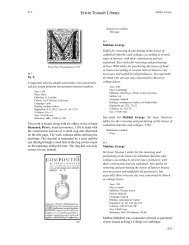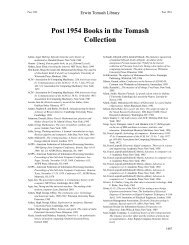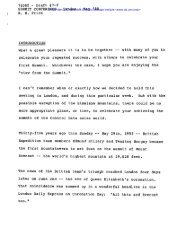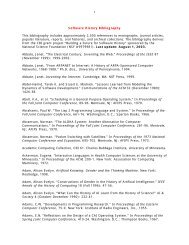B chapter.indd - Charles Babbage Institute - University of Minnesota
B chapter.indd - Charles Babbage Institute - University of Minnesota
B chapter.indd - Charles Babbage Institute - University of Minnesota
Create successful ePaper yourself
Turn your PDF publications into a flip-book with our unique Google optimized e-Paper software.
222<br />
Erwin Tomash Library<br />
Buchholz, Werner Buchholz, Werner<br />
where he remained until retiring in 1966 to take<br />
a post at Stanford <strong>University</strong>. He is best known<br />
for his early work in artificial intelligence,<br />
particularly the creation <strong>of</strong> an early checkersplaying<br />
computer program.<br />
Serrell, Robert<br />
Elements <strong>of</strong> Boolean algebra for the study <strong>of</strong><br />
information-handling systems, pp. 1366–1380<br />
Serrell was an engineer with the RCA David<br />
Sarn<strong>of</strong>f Research Center in Princeton.<br />
Shannon, Claude Elwood (1916–2001)<br />
Computers and Automata, pp. 1234–1241<br />
Shannon was a member <strong>of</strong> the technical staff<br />
at Bell Telephone Laboratories. He is best<br />
remembered for his groundbreaking theoretical<br />
work on coding and information transmission.<br />
Shannon, Claude Elwood (1916–2001) and<br />
Edward F. Moore<br />
Machine aid for switching circuit design, pp.<br />
1348–1351<br />
Both authors were with Bell Telephone<br />
Laboratories in Murray Hill, NJ.<br />
Sherertz, Paul C.<br />
Electronic circuits <strong>of</strong> the NAREC computer,<br />
pp. 1313–1320<br />
NAREC, the Naval Research (Laboratory)<br />
Computer, was just being put into operation at<br />
the Naval Research Laboratory when this paper<br />
was written. Sherertz was an engineer on the<br />
project.<br />
Thomas, Walker H.<br />
Fundamentals <strong>of</strong> digital computer<br />
programming, pp. 1245–1249<br />
Walker, from IBM’s Engineering Laboratory<br />
in Poughkeepsie, NY, presented a short tutorial<br />
on how to program a simple, hypothetical<br />
computer.<br />
Ware, Willis Howard (1920–)<br />
The logical principles <strong>of</strong> a new kind <strong>of</strong> binary<br />
counter, pp. 1429–1437<br />
Ware, an engineer with the Rand Corporation,<br />
was one <strong>of</strong> the principal designers <strong>of</strong> the<br />
Johnniac computer. Here he is reporting on<br />
work that had been done for the von Neumann<br />
computer project at the <strong>Institute</strong> for Advanced<br />
Study, Princeton.<br />
Wheeler, David J. (1927– 2004) and James E.<br />
Robertson<br />
Diagnostic programs for the Illiac, pp. 1320–<br />
1325<br />
Wheeler, working as a graduate student under<br />
Maurice Wilkes, was a designer <strong>of</strong> the EDSAC<br />
computer in Cambridge. He is responsible<br />
for, among other things, the concept <strong>of</strong> the<br />
subroutine jump instruction (initially known as<br />
the Wheeler Jump). He spent his entire career<br />
at the <strong>University</strong> <strong>of</strong> Cambridge, but at the time<br />
<strong>of</strong> this paper, he was on leave working at the<br />
<strong>University</strong> <strong>of</strong> Illinois ILLIAC project.<br />
Wilkes, Maurice Vincent (1913–)<br />
Can machines think?, pp. 1230–1234<br />
B 283







